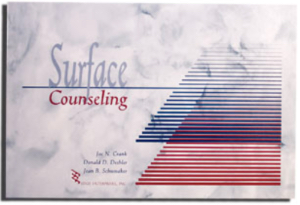Surface Counseling

Surface Counseling is a problem-solving and decision-making process that adults can use with youths who have day-to-day personal problems. Embedded in the process is a strategy that youths can learn to use independently. In studies, before studying this manual, teachers performed an average of 23 percent of surface-counseling skills in sessions in which they counseled youths. After reading the manual, answering study-guide questions, and listening to an audio-tape of a surface-counseling session, they performed an average of 93 percent of the skills.
Although some children seem to be in a state of perpetual anxiety, the problems causing this anxiety can definitely be real. Whether the source of the anxiety is the boy down the street, a callous remark from an unthinking peer, or an argument with someone at home, young people need help learning how to solve the kinds of problems they face every day. Without such help, their problems can interfere with learning.Thankfully, most of the problems young people encounter don’t require a degree in psychology to solve. Using the Surface Counseling process, anyone who comes into contact with young people can provide the first level of help. The Surface Counseling process begins with developing a trusting relationship and involves prompting the youth through a set of problem-solving steps that the youth can eventually use on her own. The specific details of all these steps are outlined in this down-to-earth guidebook, and it includes role-play situations and worksheets for copying and using. The Surface Counseling process is a great tool for parents, teachers, and coaches—anyone who’s interested in helping young people grow and learn.
Author(s): Joe N. Crank, Donald D. Deshler, and Jean B. Schumaker
Publication Info: Edge Enterprises, 1995
The Story Behind Surface Counseling from author Joe Crank:
The term and basic rationale for Surface Counseling were mentioned in the original Alley and Deshler text (1979). I was intrigued by the idea because during my training and work in schools as a school psychologist, I noticed that teachers and even other professionals did not seem to be providing the kind of basic guidance that they could that would be helpful to students. With the advisement of Don Deshler and Jean Schumaker, I elaborated on the Surface Counseling concept, and we developed the Surface Counseling routine and the training program for teachers and other mentors who work with youngsters. Essentially, Surface Counseling is a method for mentors to use when working with youths to help them solve personal and social problems. The co-goal is for youngsters to become independent problem solvers. The skills and steps of Surface Counseling form the basis for a way of interaction, a routine for teacher/student communication.
Author's Thoughts about Surfacing Counseling:
I see Surface Counseling as being a method of communication between teachers and students or between mentors and children in their charge. It is a professional and sincere way of dealing with children who are having problems socially. Some of the creative educators and counselors with whom I have worked with have translated the surface counseling methods and worksheets into daily or weekly social skills lessons in which students can be taught and role play the problems-solving steps in groups. In a broad way, Surface Counseling is very much a strategic method both in its delivery with children and in the problem solving steps that are embedded in the whole routine.
Feedback about Surface Counseling:
A study by Loe, Jones, Crank, and Krach (2009) was undertaken to evaluate Surface Counseling for counselors and school psychologists in graduate training. Their study replicated the results of the original research study (see the research section on Surface Counseling). The outcome of the study has resulted in the use of the original Surface Counseling self-instruction methodology and material for graduate training in areas that are kindred to teacher education.
In another study, Lee and Crank (2005) used a qualitative method for gathering and evaluating teachers’ feedback about the Surface Counseling process with teachers making the following observations as a few examples: “It has a structured order;” “It allows students to help themselves;” “It shows students you care;” “It uses well-detailed checklists and worksheets;” “It gets the students to become involved in taking responsibility for their actions;” “Students know you care;” “Students say they have more than one way to solve (get out of) a bad situation;” and “Students say they like the problem-solving brainstorming activity.”
This product is published by Edge Enterprises, Inc.